To create your perfect floral heart perfume, start with 2-3 key floral oils like jasmine, rose, or orange flower in equal parts. You'll need digital scales, glass beakers, and protective gear for precise, safe blending. Test combinations on fragrance blotters, adding modifiers drop by drop until you achieve your desired scent. Store your creation in amber bottles and let it age for at least 48 hours. With the right tools and techniques, your signature scent awaits.
Understanding the Art of Floral Heart Notes
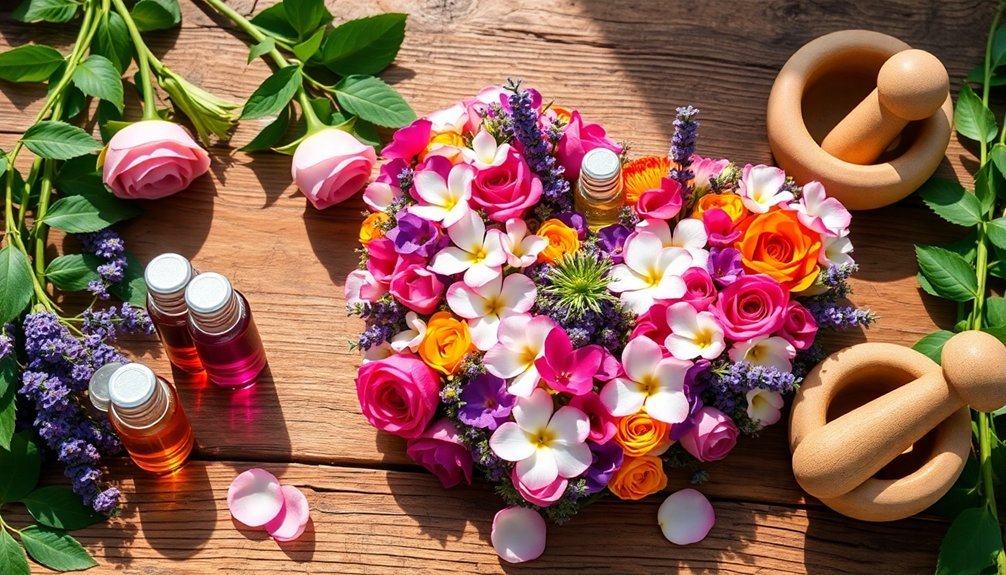
When you start exploring the world of DIY perfumery, understanding heart notes becomes essential to creating a balanced fragrance. These notes emerge after the initial burst of top notes fades, typically within 30 minutes to an hour after application, forming your perfume's core character.
If you're working with floral heart notes, you'll discover a diverse palette ranging from delicate to bold scents. You can experiment with white flowers like jasmine and tuberose, powdery notes like iris and violet, or spicy flowers like carnation. The robust and complex scents of these heart notes will persist for several hours on your skin.
Each category offers unique characteristics that'll help shape your fragrance's personality.
To create harmony in your DIY perfume, you'll need to carefully blend these floral notes with other components. Consider combining them with spicy or fruity notes to add warmth or freshness to your creation.
Essential Tools and Materials for Your DIY Journey
Now that you understand the artistry of floral heart notes, let's focus on assembling your perfume-making toolkit.
You'll need precision instruments like digital scales (accurate to 0.01g) and glass beakers for measuring and mixing. Don't forget essential tools like fragrance blotters for testing and pipettes for transferring liquids.
For your safety, you'll want protective gear: gloves, safety glasses, and masks to shield you from strong fumes. Secure storage containers are crucial for keeping your raw materials and finished products organized and safe.
Store your creations in amber Boston round bottles with droppers, and use labels to track your blends.
For advanced work, you'll benefit from specialized equipment like lab-quality filter paper, metal spatulas, and a magnetic stirrer for efficient mixing.
A conductivity meter helps measure solute concentration, while a separatory funnel aids in extracting essential oils from hydrosol.
The Science Behind Middle Note Fragrances
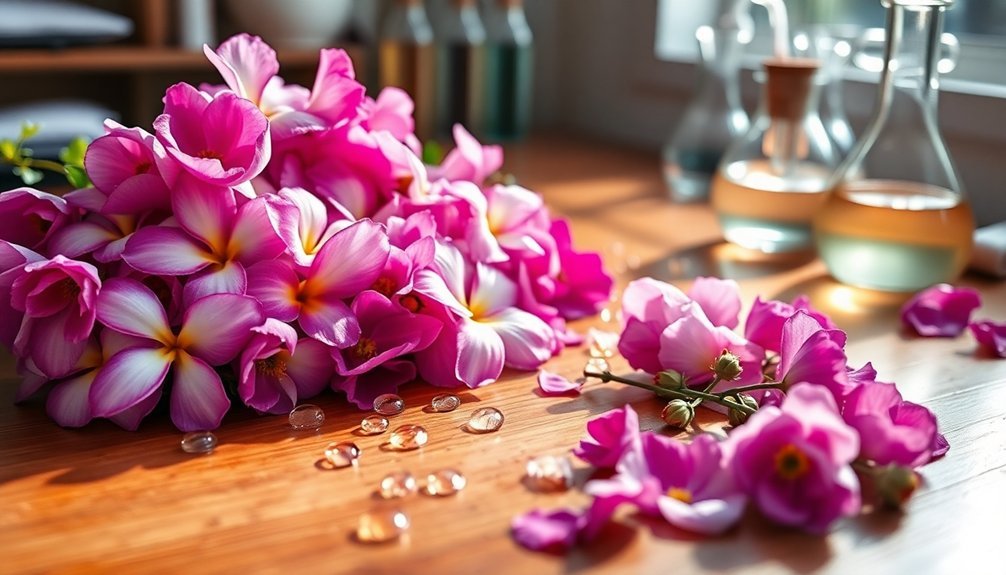
The heart of any perfume lies in its middle notes, which emerge as the initial top notes fade away. You'll find these notes lingering for 20-60 minutes, making up 40-80% of your fragrance blend.
They're essential in bridging the gap between your perfume's opening burst and its final base notes. Just like a musical composition, middle notes create harmony between all fragrance elements.
When you're crafting your DIY perfume, you'll want to focus on floral, fruity, or spice-based middle notes like jasmine, rose, cinnamon, or cardamom. These ingredients create the perfume's core character and maintain its narrative throughout wear.
They're responsible for bringing warmth, depth, and balance to your creation.
For the best results, guarantee your middle notes harmonize well with both top and base notes. This careful orchestration will keep your fragrance engaging and well-balanced as it develops on your skin.
Popular Floral Oils for Heart Notes
Among the most cherished ingredients in perfumery, floral oils serve as exceptional heart notes that create depth and character in your DIY fragrances. You'll find that rose oils, available in both delicate absolute and spicier varieties, form the foundation of many romantic blends.
| Floral Oil | Key Characteristics |
|---|---|
| Jasmine | Sweet, sensual, intense |
| Lily of Valley | Fresh, delicate, spring-like |
| Orange Flower | Soothing, invigorating, balanced |
When crafting your signature scent, you can combine these florals to achieve your desired effect. Try pairing jasmine sambac with rose for a rich, romantic blend, or mix lily of the valley with orange flower absolute for a fresh, bridal-inspired fragrance. You'll discover that tuberose and ylang ylang add an exotic twist, helping bridge your top and base notes seamlessly.
Blending Techniques for Lasting Floral Impact
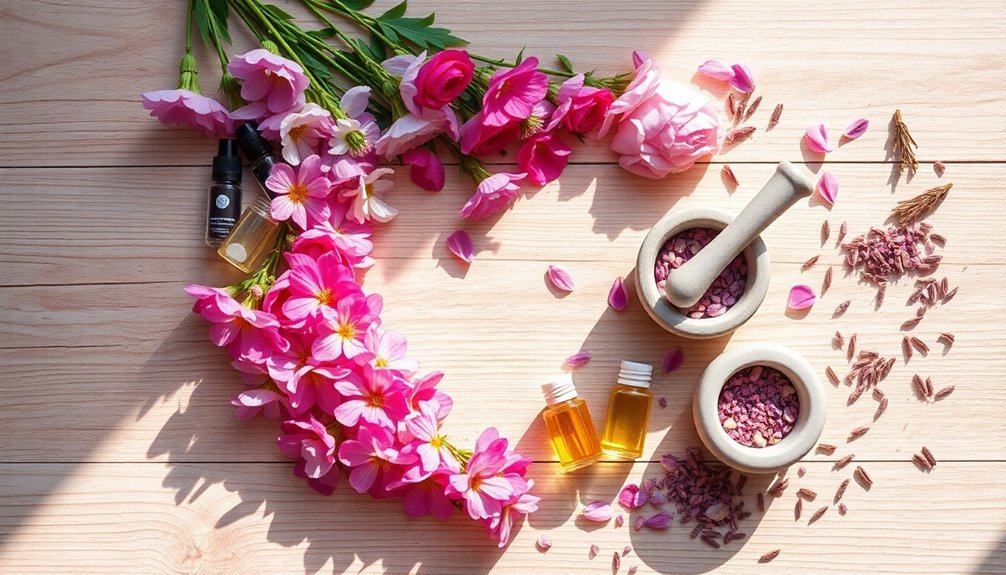
Building upon your knowledge of floral oils, mastering proper blending techniques will determine how your signature scent develops and lasts throughout the day. Start by selecting 2-3 key floral materials in equal parts, then adjust their proportions until you achieve the desired harmony.
Next, add modifiers drop by drop, testing each addition before proceeding. You'll want to incorporate blenders like lavender or citrus oils to smooth out shifts between notes and create balance. Don't rush this process – each element needs careful consideration.
Finally, secure your creation's longevity with fixatives such as vetiver, amyris, or benzoin. These essential oils provide depth and staying power without overwhelming your carefully crafted floral heart.
Remember to label each sample as you work, allowing you to track your progress and replicate successful combinations.
Balancing Your Floral Heart With Base Notes
When balancing your floral heart notes, you'll need a solid foundation of heavy woods like sandalwood or cedarwood to provide essential depth and stability.
Vanilla acts as a natural anchor for your floral components, creating a warm and smooth shift between heart and base layers.
For rose-centered blends, adding musk will enhance the natural qualities of the flower while ensuring your fragrance maintains its character throughout the day.
Heavy Woods Add Depth
The rich, earthy character of woody base notes transforms a simple floral perfume into a complex masterpiece. When you're creating your signature scent, consider adding classic woods like sandalwood, vetiver, or cedar to anchor your floral heart notes.
These heavy base notes aren't just about adding depth – they're essential for your perfume's longevity. Their heavier molecular structure means they'll stick around for six hours or more, emerging gradually as your top notes fade.
You'll want to experiment with different ratios, keeping your middle notes at 50-75% of the blend while balancing them with these lasting woods.
Popular choices include creamy sandalwood for sensuality, smoky vetiver for earthiness, or clean cedar for somber sophistication. For a twist, try slightly sweet patchouli or rich tonka bean to complement your florals.
Vanilla Anchors Floral Notes
Just as flowers need roots to thrive, your floral perfume needs vanilla to ground its delicate notes. When you're creating your signature scent, vanilla acts as the perfect anchor, providing warmth and longevity while enhancing your chosen florals.
| Floral Note | Vanilla Ratio | Effect |
|---|---|---|
| Rose | 1:3 drops | Deepens romance |
| Jasmine | 1:2 drops | Adds sensuality |
| Orchid | 1:4 drops | Creates luxury |
| Lily | 1:3 drops | Softens sharpness |
| Lavender | 1:2 drops | Balances freshness |
You'll want to start with a single drop of vanilla in your carrier oil, then carefully layer in your floral notes. As you blend, you'll notice how vanilla's sweet, creamy character helps create a seamless shift between your middle and base notes, ensuring your perfume maintains its beautiful character throughout the day.
Musk Enhances Rose Blends
Masterfully balancing a rose blend requires the subtle touch of musk to transform your fragrance from simply floral to deeply alluring.
You'll find that musk adds a warm, creamy foundation while softening sharp floral notes into a smoother, more wearable scent.
For your rose blend, you can choose from several musk varieties.
White musk offers a soft, clean character, while Egyptian musk delivers a richer, more sensual quality.
If you're looking for consistency, synthetic musk provides reliable results.
To create depth, try combining your musk with complementary notes like vanilla, cardamom, or amber.
You'll notice musk doesn't just enhance the scent – it acts as a fixative, extending your perfume's longevity and improving its sillage.
This makes your rose blend more stable and guarantees it leaves a memorable, lingering impression.
Top Note Pairings for Floral Perfumes
When crafting floral perfumes, you'll find that citrus top notes like bergamot, lemon, and mandarin can add an energetic lift to your blend while maintaining sophistication.
You can create depth by experimenting with sweet combinations, particularly pairing florals with fruits like peach or strawberry.
For a more grounded approach, consider woodsy elements like cedar or sandalwood to balance the lightness of your floral heart notes.
Fresh Zesty Citrus Blends
Creating fresh citrus blends starts with selecting the perfect top notes that'll bring vibrant energy to your floral perfumes.
You'll find lemon provides an uplifting aroma, while grapefruit dominates with its intense summer-ready scent. Consider bergamot for balance, mandarin for sweetness, or lime for zesty brightness.
To enhance your citrus blend, pair it with floral heart notes like jasmine or freesia.
These combinations create depth without overwhelming the fresh top notes. You can add neroli for a slightly sweet touch or lotus flower for a clean, light aspect.
For lasting power, ground your creation with woody base notes like cedarwood or vetiver.
If you're aiming for a romantic twist, incorporate amber or vanilla.
Sweet Woodsy Combinations
The art of sweet woodsy combinations begins with selecting the right top notes to complement your floral perfumes.
You'll want to start with vibrant options like cara orange, pineapple, or nectarine to create an immediate impact. If you're avoiding citrus, try synthetic alternatives like anisyl alcohol or linalool for that perfect floral lift.
For your middle notes, focus on classic florals like jasmine, rose petals, and lily of the valley.
These heart notes will blend seamlessly with your top notes while creating a bridge to your base notes.
When it comes to those lasting base notes, opt for warm, rich elements like patchouli, vanilla, or sandalwood.
You can enhance the woodsy aspect by incorporating cedarwood or oud, which pair beautifully with the floral heart notes.
Aging and Preserving Your Floral Creation

Understanding how to age and preserve your homemade perfume will determine its ultimate success. Your floral creation needs proper aging to develop a harmonious blend where top notes soften and deeper notes emerge.
Store your perfume in a dark glass bottle with a tight seal, keeping it at a consistent temperature between 59°F to 68°F.
For ideal aging results:
- Let your mixture rest for at least 48 hours initially
- Keep the bottle in a cool, dark place like a drawer
- Avoid exposure to direct sunlight and humidity
- Label your creation with the date and ingredients
While some perfumes may show results in a few weeks, you'll achieve the best complexity by aging your floral creation for 6 months to a year.
Remember that natural ingredients require more patience but will reward you with a richer, more mature scent profile.
Troubleshooting Common Floral Blend Issues
When working with floral blends, you'll likely encounter common challenges that can affect your perfume's final result. To troubleshoot effectively, start by evaluating each component individually and documenting your adjustments. If your blend feels unbalanced, add modifiers drop by drop while testing after each addition.
| Issue | Solution |
|---|---|
| Overpowering Notes | Balance strong materials with lighter ones, adjusting proportions gradually |
| Lack of Cohesion | Use blending agents like lavender to smooth connections between notes |
| Flat Composition | Add subtle accent notes and fixatives carefully to enhance depth |
Let your blend mature for several days to allow the ingredients to meld. Remember to maintain proper documentation of your modifications, as this will help you track what works and what doesn't. When making corrections, always work in small increments to avoid over-adjustment.
Frequently Asked Questions
Can I Use Dried Flowers Instead of Essential Oils for Perfume Making?
Yes, you can use dried flowers instead of essential oils. They'll give your perfume a natural fragrance, though it might be less potent. Simply infuse them in carrier oil for 24-48 hours and strain.
Why Does My Floral Perfume Smell Different on Different People?
Your floral perfume smells different because everyone's skin chemistry, pH levels, and micro-flora are unique. Your diet, body temperature, and even stress levels can change how fragrance molecules interact with your skin.
Are Synthetic Floral Fragrances Safer Than Natural Essential Oils?
You'll generally find properly tested synthetic fragrances safer than natural oils, as they're free from allergens, pesticides, and heavy metals. They're also more consistent and undergo strict safety testing by regulatory bodies.
How Can I Make My Floral Perfume Last Longer in Hot Weather?
You'll get better longevity by applying your floral perfume to well-moisturized skin, focusing on pulse points like wrists and neck. Choose an EDP formula and layer it with matching body lotion for extended wear.
Is It Possible to Create Floral Perfumes Without Using Alcohol?
Yes, you can create alcohol-free floral perfumes using natural oils as carriers, purified water as a base, and essential oils for fragrance. You'll get gentler scents that are kinder to your skin.
In Summary
Now you're ready to commence your perfume-making journey. Don't let initial setbacks discourage you – creating the perfect floral heart takes practice and patience. Keep experimenting with different combinations until you find your signature blend. Remember to document your successes and failures, and trust your nose. With these foundational skills, you'll create unique, personalized fragrances that truly reflect your style.
References
- https://www.youtube.com/watch?v=4g56AAGkdjo
- https://sinhp.github.io/files/posts/2018/little-brown-book.pdf
- https://livesimply.me/diy-homemade-perfume/
- https://www.178wing.ang.af.mil/Portals/69/documents/afh33-337.pdf?ver=2016-12-15-101008-313
- https://www.instructables.com/How-to-make-perfume/
- https://saifperfumes.com/blog/a-guide-to-perfume-notes/
- https://aymahfragrances.com/blogs/news/heart-notes-a-comprehensive-guide-to-perfume-ingredients
- https://makesy.com/blogs/news/learn-the-basics-of-making-perfume
- https://www.pairfum.com/heart-notes-in-perfume-the-soulful-core-of-a-fragrance/
- https://www.sylvaine-delacourte.com/en-us/guide/heart-notes

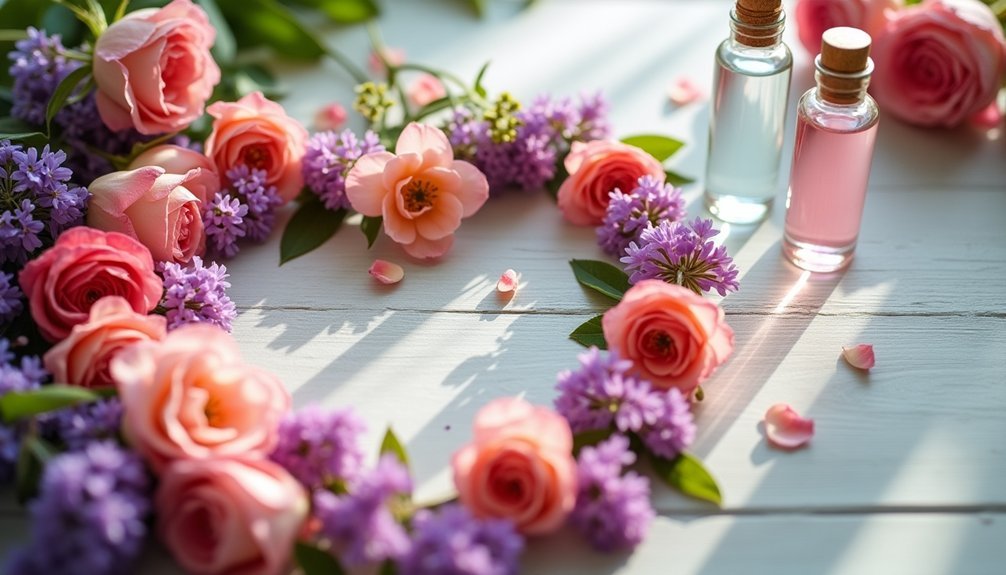
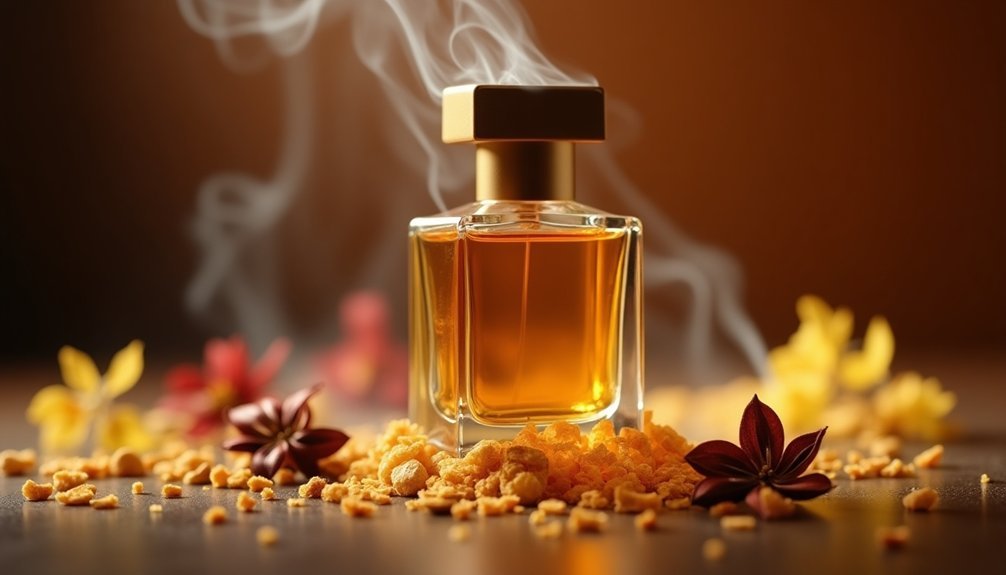

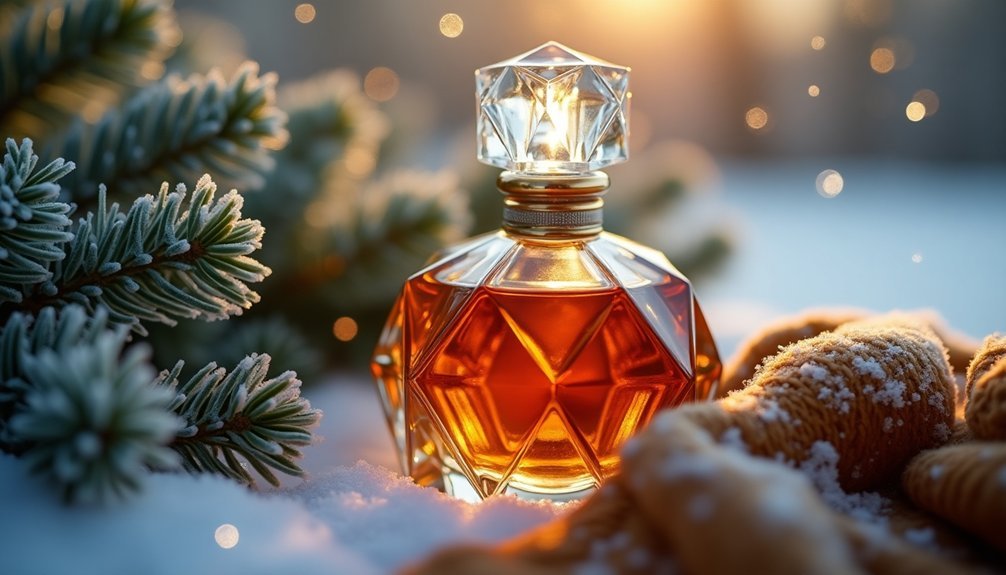
Leave a Reply